ARCHIVED: Chapter 15. Cold-Mix Asphalt Recycling (Case History And QC/QA)
| << Previous | Contents | Next >> |
Introduction
Cold-mix recycling is a rehabilitation technique that reuses existing pavement material without the application of heat. Generally a recycling agent and/or asphalt binder (for example, emulsified asphalt) is added to the reclaimed asphalt pavement (RAP) material. In this technique, the existing pavement is pulverized, the RAP is sized, if necessary, recycling agent is added to the mix, and finally the mix is placed and compacted. Similar to conventional hot mix asphalt, cold recycled mix must be produced and placed according to proper guidelines and specifications. Since there are no universally acceptable guidelines on cold-mix recycling, it is always helpful to review the experience of past users and guidelines developed by different agencies. The objective of this chapter is to present some selected case histories and specifications including quality control and quality assurance (QC/QA) practice of some highway agencies.
Case Histories
Mercer County Project, Pennsylvania(1) (1985)
An in-place recycling project was completed in Mercer County, Pennsylvania on Traffic Route 208 (west of I-79 London interchange) in May 1985. The recycling train (figure 15-1) consisted of an emulsion tanker, a milling machine, a crusher, a mixer, and a paver. The milled material passed over a 38-mm (1½-in) scalping screen. The oversized material was fed into the crusher by a conveyor to reduce its size. The material was milled and recycled to a 75 mm (3 in) depth. Because no provision was made for adding water before the material was mixed with the CSS-1h emulsion, the latter was diluted with water in a 50:50 ratio to provide an acceptable dispersion of the binder.
Figure 15-1. Recycling train.
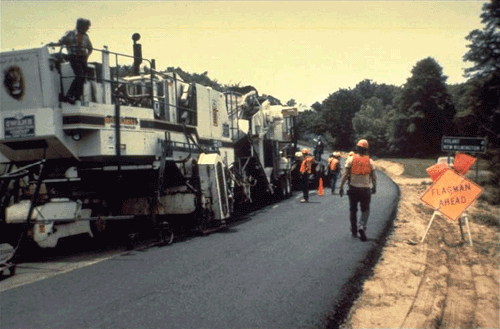
It was noted that the gradation of the RAP on this project was significantly finer than the laboratory-generated RAP. About 3 percent (approximately 0.03 liter/kg, 7½ gal/ton) CSS-1h emulsion by weight of the RAP was used. Compaction was performed with a vibratory and a pneumatic-tired roller. Because the average daily traffic on this road was 2,000 to 3,000, the recycled base course was overlaid with 90 mm (3½ in) hot mix overlay. The recycled pavement had been performing satisfactorily when it was inspected in 1986 after one year (figure 15-2).
Figure 15-2. Condition of road after recycling.
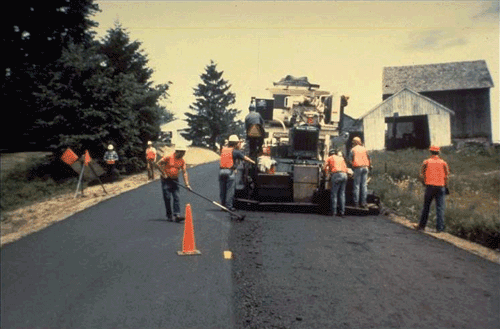
US 64 Project, New Mexico(2) (1984)
This cold in-place recycling operation was performed on US 64 in New Mexico in 1984. The existing pavement consisted of 75 mm (3 in) HMA over 150 mm (6 in) sand and gravel base. The existing surface exhibited extensive medium to high severity transverse, shrinkage and fatigue cracking (figure 15-3), and extensive moderate to high severity rutting. The surface also had extensive maintenance patching. Cold in-place recycling was done up to a depth of 100 mm. A polymer modified, high float emulsion was used at rate of 1-3 percent. The quantity of recycling agent was based on laboratory mix design, but was adjusted on the basis of field requirements. A 100 mm HMA overlay was used on the recycled base. The equipment train used for recycling consisted of a milling machine, crusher, mixer, and paver (figure 15-4). The milling machine milled the existing pavement and transferred the material to the crusher. The milled RAP material was screened and sized in this equipment. The maximum size of the RAP material was reduced to 32 mm (1.25 in). The screened and sized RAP material was mixed with emulsion in the mixer. A truck supplied the emulsion to the mixer. The mixer then laid down the recycled mix in a windrow. The paver picked up the recycled mix from the windrow and laid it down with a screed. Heavy pneumatic-tired rollers (27 Mg, 30 ton) were used for breakdown compaction. Steel-wheel rollers were used for final compaction (figure 15-5). Survey results reported in 1996 indicated that the pavement was performing adequately.
Figure 15-3. Condition of existing road.
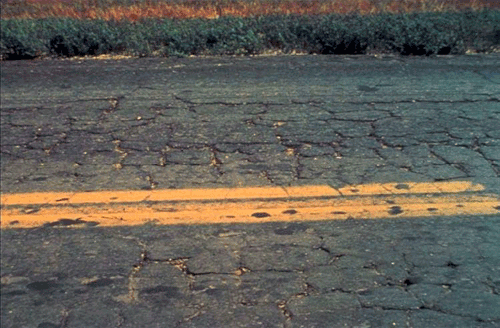
Figure 15-4. Recycling train.
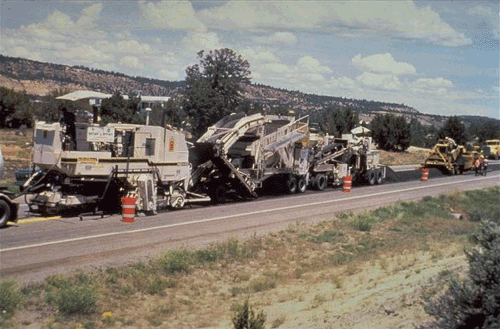
Figure 15-5. Pneumatic-tired breakdown roller.
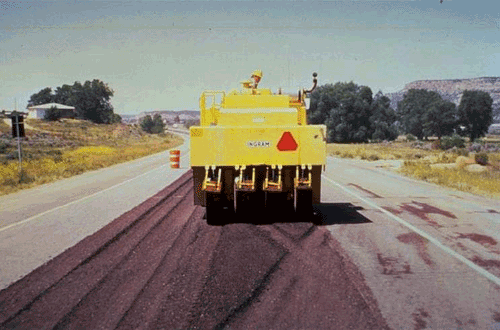
Baltimore County, Maryland(3)
Cold in-place recycling was done to rehabilitate a deteriorated road in Baltimore County in Maryland. The existing road had thermal cracking, rutting, poor profile and alligator cracking and patching (figure 15-6). Since this road is the only artery feeding a hospital, emergency and general business traffic had to be maintained. Hence the road could not be totally closed. Both sides of this road had concrete gutters. Following rehabilitation through recycling, the hot mix wearing surface needed to meet the top of the gutter. This means that the 100 mm (4 in) recycled base course had to be 37.5 mm (1.5 in) lower than the top of the gutters when compacted. With CIR, it was decided to move the recycled material into the center of the road and build a 20 percent cross slope. Recycling was done with an asphalt tanker, pushed by a down-cutting full lane width (3-m wide) milling machine, with an appropriately computerized asphalt additive system. The old roadway material was milled and mixed with new asphalt in a single operation, then deposited directly into a paver and relaid to the desired depth (figure 15-7). The recycled material could be driven on without major problem. Traffic flowed around the construction equipment under restricted lanes and speed.
Figure 15-6. Existing road.
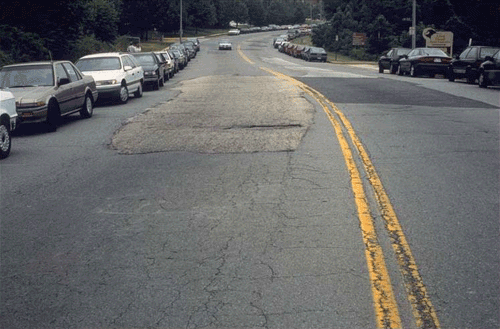
Figure 15-7. Recycling train.
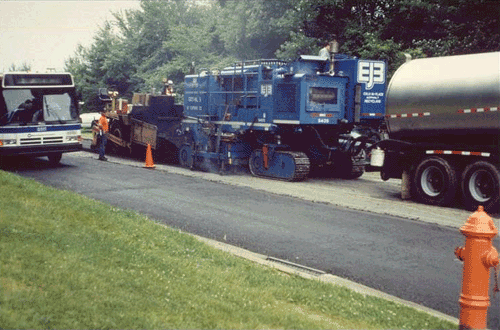
The recycled mix was left to cure for a period of seven days. Traffic was allowed to use the newly recycled section with no restriction. To achieve ideal compaction, a combination of a pneumatic 27 Mg (30 ton) smooth-tired roller and a steel wheel 10.8 Mg (12 ton) vibratory roller were used (figure 15-8).
Figure 15-8. Rollers used for compaction.
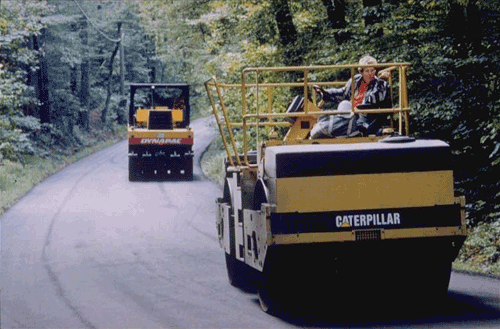
Recycling Around Utilities(3)
Generally, a box is painted around the utility to first guide the operator of a small milling machine as to how much of the roadway must be milled to accommodate the larger recycling machine (figure 15-9). The 40 cm (16 in) head of a small milling machine goes around the utility to the depth of the new base course (figure 15-10). The milled material stays in-place around the utility until the larger recycling machine approaches. Then, all of the milled material is excavated out from the cut area, and placed on the old roadway where it is processed with the recycling machine. As the recycling machine pulls the paver behind it, it lays the new recycled base course around the utility, recycling 100 percent of the existing material (figure 15-11).
Figure 15-9. Marking utility.
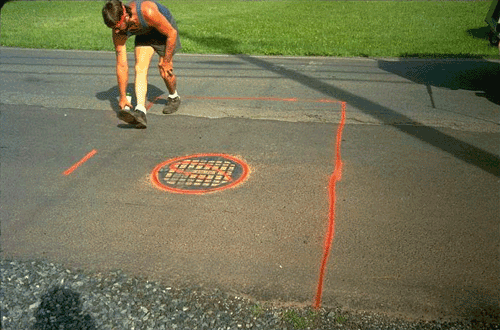
Figure 15-10. Milling around utility.
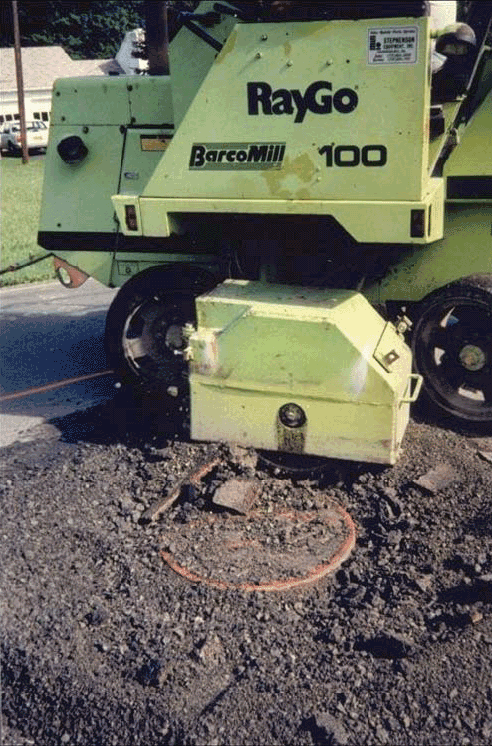
Figure 15-11. Recycled material around utility.
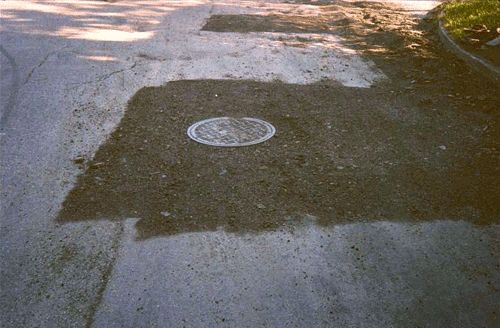
Specifications And QC/QA
There are primarily two types of specifications. The method specification specifies the equipment to be used and all construction processes. An end result specification sets control limits on some test property of the finished pavement. However, as in the case of other recycling procedures, in cold-mix recycling it is better to have a specification which is a combination of the method and end result specifications. This allows the effective use of the experience and expertise of the user agency, the contractor, and the equipment manufacturer to obtain a good pavement at a reasonable cost.(4) Since there is usually a great variation in material properties in cold-mix recycling, specifications for cold-mix recycling tend to be more end result oriented than method specification.(5) For example, the specification may allow either in-place or plant mixing, provided the recycled mix meets the specification, and any type of milling or pulverization equipment may be used if the depth of the cut and the gradation of the RAP material (for example, top size) meet the required specification tolerance.
The top size of the RAP material is usually specified by most agencies. It is realized that this requirement can slow down the recycling process, since the top size of a milled or pulverized material is a function of the condition of the existing pavement (oversized material may be produced from a pavement with alligator cracking), top size of the original aggregate, and the depth of the cut (thicker cuts may produce chunks of greater size).(6) Nonetheless, this requirement is essential for smooth and uniform laydown operations. The gradation of the existing road materials should be taken into account when writing the specification for the aggregate gradation. Due to the inherent variability of material in cold-mix recycling, it may not be practical to specify aggregate gradation for all the sieve sizes. However, the equipment used in cold-mix recycling (pulverization, for example) should be capable of cutting the pavement to the specified depth reasonably well.
The next important thing in cold-mix recycling is the specification for the asphalt recycling agent. The recycling agent should conform to the appropriate AASHTO, ASTM or state specifications for different types of asphalt binders, such as emulsified asphalt. Also, the equipment used for adding the recycling agent should be capable of an accurate application rate such that the total binder content of the recycled mix is equal to the job-mix formula amount within a specified tolerance, typically ± 0.5 percent.(5) The specification should also include clear directions regarding accurate application of any pre-mix water. Generally no limits are placed on the amount of RAP to be used, but any new material to be used should be tested for specification compliance. The responsibility for establishing the job-mix formula and the required sampling procedures, test methods and design criteria for the mix design should be clearly outlined in the specification.(5)
Adjustments to the gradation or asphalt content of the recycled mix can be made based on the results from the extraction tests conducted on recycled mix. Conventional methods of extraction (reflux, centrifuge, vacuum) which use solvents are being phased out by many highway agencies. Asphalt content and gradation of the aggregate in the recycled mix can be determined by the recently developed ignition method. The density of the compacted mat is another important test property for specification. The density can be specified either as a percentage of theoretical maximum density or laboratory density, or as a target density. The use of theoretical maximum density is recommended over the use of laboratory density, since there may be substantial differences in temperatures, fluid contents and other conditions between laboratory and field compactions. Specification of a target density (in actual kg/m3, lb/ft3 unit) combined with an adjustable rolling pattern has also been suggested to overcome the problem of material variability in the existing pavement.(7) When deciding on a density specification, prior experience with similar type of recycling and environmental conditions should be taken in account.
In the absence of proper performance data for developing statistically based specifications, it is suggested that the user agency remain flexible and evaluate several alternatives to encourage competition.(5) The specification should be written in such a way that it reflects the following functions of the user agency:(4)
- Be responsible for the adequacy of design alternatives.
- Write simple straightforward specifications which clearly state what is expected.
- Permit the contractor to select the materials and methods which will accomplish the end result.
- Use standard specifications familiar to the contractor.
- Modify standard specifications only as necessary to obtain the end result.
- Focus on end results by allowing the contractor flexibility in choosing the most economical methods and procedures to accomplish the work.
The important features of cold-mix recycling specification from the Asphalt Recycling and Reclaiming Association, and the states of New Mexico , Oregon and Pennsylvania are presented below.(8) The New Mexico DOT specification is given in Appendix B for ready reference.
Asphalt Recycling and Reclaiming Association (ARRA)
Specification regarding gradation of pulverized material, equipment, and construction requirements are provided. Specifications for equipment include description of mixes and construction operations for paver and roller. Guidelines regarding minimum allowable air temperature and tolerance for the application rate of recycling agent or additive are also provided.
New Mexico
The New Mexico cold in-place recycling specification describes material, equipment, and construction requirements. Type of emulsions and gradation of recycled material are specified. Descriptions of cutting rotor and asphalt application pump for mixers are provided. Required criteria for operations of paver and roller are also mentioned. For construction requirements, minimum air temperature and application rate of emulsified binders are specified.
Oregon
The Oregon specification describes requirements for maximum size of RAP material, construction equipment and methods. Requirements for components of recycling train, including planing machine, crusher, and mixer are described. Weather conditions required for recycling operation are specified. Requirements for temperature of emulsified asphalt cement, mixing and rolling are also specified. Method specification has been provided for initial compaction and recompaction of cold in-place recycled pavements.
Pennsylvania
The Pennsylvania DOT provides an end result specification for cold in-place recycling. General guidelines regarding type of equipment are provided. Requirements for mixing and transporting cold recycled (central plant) mix are given. Required criteria for mobile mixing plants are specified. For compaction, minimum and maximum depth of compacted layer are specified. Guidelines regarding rolling operation and use of a control strip to establish rolling pattern have been provided.
The following guidelines are recommended on cold-mix recycling:(8)
- Cold in-place recycled mixtures should not be placed in depths greater than about 75 mm to 100 mm (3 to 4 in), because curing can be a problem, nor should depths be less than about 50 mm (2 in), because segregation may be a problem during construction. However, when portland cement or Class C fly ash has been used with asphalt emulsions, depths up to 150 mm (6 in) have been possible.
- Softening of the recycled mix may occur within the first two to three days. Some agencies re-roll the pavement at this time to obtain additional density.
- An excessive amount of initial compaction can cause problems. However, several states, including New Mexico and Pennsylvania, do not re-roll their pavements after construction.
- Traffic should not be allowed on the recycled pavement for a minimum of two hours after compaction.
- If the surface starts to ravel under the action of traffic, a fog seal should be applied as soon as possible.
- Rain within 24 hours of construction can create performance problems depending upon the type of emulsified asphalt used.
- Before placing the wearing surface, curing should be allowed to reduce the moisture content to the 1 to 1.5 percent range. Summertime curing for 7 to 14 days is typically used. Late season construction can cause performance problems.
- Problems with density control are common. Nuclear density devices provide relative numbers. Cores may not be able to be obtained without proper curing (which may be one year).
In conclusion it should be mentioned that final adjustments to mix design must be made during construction. A recent survey(9) indicates that 60 percent of the agencies surveyed based their adjustments on combinations of experience and workability.
Quality Control and Quality Assurance
Quality control (QC) refers to those tests necessary to control a product and to determine the quality of the product being produced. These QC tests are usually performed by the contractor. Because of greater variation expected in the case of cold recycled asphalt mixtures, the frequency of testing should be more, even though the same tests that are used in the case of conventional HMA may be used. Before starting construction, it is very important to know the quality of the existing pavement, in terms of aggregate gradation and asphalt content of the mix. The pavement should first be delineated into subprojects, on the basis of differences in design, maintenance, and rehabilitation actions. Once the subprojects are identified, representative samples should be taken from each of the subprojects. In this way, the variation in the existing material can be identified and evaluated.
The quality control for cold-mix recycling is primarily dependent upon the equipment used. The equipment should be such as to allow the following operations:(10)
- Pulverization of recycled pavement material to the desired size.
- Proper pre-mix water content (uniformly mixed).
- Proper recycling agent content (uniformly mixed).
- Attainment of some minimum specified mat density.
Favorable temperature and moisture conditions are necessary for strength development during the curing period. The stabilized surface should be protected from traffic to prevent abrasion and to ensure adequate time for strength development.
The following are the potential problem areas for in-place and central recycling:(5)
- Depth of removal and pulverization.
- Blending associated with addition of new aggregate, water, stabilizers, or modifiers.
- Degree of pulverization.
- Distribution of modifiers, water, or stabilizers.
Table 15-1 presents the material sampling and testing procedures for quality control, as suggested by AASHTO-AGC-ARTBA.(11) The items that should be monitored are listed below. The specific characteristics which need to be evaluated are mentioned in parentheses.
- RAP Gradation (maximum size).
- Recycling agent (type and amount).
- Moisture (amount).
- Compacted density.
- Depth of milling.
- Spreading depth/cross slope.
- Mixing Equipment (calibration).
| Type of Testing | Purpose of Testing | Frequency | Sample Location and Size |
|---|---|---|---|
| Recommended for Control and Testing | |||
| RAP gradation, 50 mm, 37.5 mm, or 31.5 mm (2", 1½", or 1¼") sieves | Specification compliance with maximum RAP size determined | Each 0.8 km1,6 (½ mile) | From conveyor belts, windrows or mat, minimum weight of 9.1 kg (20 lb)2 |
| Asphalt emulsion, recycling agent, portland, fly ash, and lime | Check on specification compliance | Every load sampled, one test per day | From asphalt tank on recycling unit or transport truck, wide-mouth plastic bottle, 1 L (1 qt) sample size3 |
| Moisture added to RAP4 | Adjustment of water content for proper mixing and compaction | Each 0.8 km1,6 (½ mile) | From belt into mixer or after spreading, minimum weight of 9.1 kg (20 lb)2 |
| Mat moisture content after curing (emulsions/recycling agents only) | To determine when the new asphalt surface can be placed | Each 0.8 km (½ mile), one each lane1,6 | Full lift depth sample, minimum weight of 1.4 kg (3 lb)2 |
| Recycling additive content | Verify amount of recycling additive and also accuracy of meter readings | Minimum of one per day | By tank gauging, transport truck weighing or meter readings and RAP weight by belt scale readings |
| Recycled material compacted density by rolling control strips5 | To establish rolling procedures and target density for specification compliance | Minimum of two strips and nuclear density testing each 0.8 km (½ mile)1,6 | Strips at beginning of project and additional if major changes in recycled mixture properties occur, 120 to 150 m (400 to 500 ft) length |
| Or | |||
| Recycled material compacted density by field compacted specimens5 | To establish the target for specification compliance | Material sample and nuclear density testing each 0.8 km (½ mile)1,6 | Material sampled from windrow or mat after spreading, minimum weight of 9.1 kg (20 lb)2 |
| Depth of pulverization/milling | For specification or plan compliance | Each 0.2 km (1/8 mile) or additional as needed | Measurements across the mat, adjacent to longitudinal joints and at the outside edge |
| Recommended for Control and Testing | |||
| Spreading depth of recycled material, central plant cold recycling only | Check of the lift thickness for specification or plan compliance | Each 0.2 km (1/8 mile) or additional as needed | Measurements across the mat, adjacent to longitudinal joint and at the outside edge |
| Mixing equipment calibration | To assure proper content of the recycling additive and moisture | Prior to beginning of work each year and additional as needed7 | Material being recycled from mixer into a truck and liquids into barrels, tanker or asphalt distributor for weighing by a scale |
| For Information Only | |||
| Recycled material temperature | To determine the influence of temperature on compaction and temperatures for mix design | Minimum of four each day, two early morning and two late afternoon | Determined for the recycled material when mixing and the mat immediately prior to the beginning of compaction |
| Recycled mat smoothness | To develop data on spreading and for possible future specification requirements | Continuously or at selected locations of existing pavement and after cold recycling | By profilograph device (California or other) |
| Original pavement and recycled material asphalt contents (by solvent extraction)8 | To determine added and total asphalt contents | Randomly6 | From selected locations in a stockpile or pavement before recycling and in the recycled mat, minimum weight of 9.1 kg (20 lb)2 |
Notes:
- Additional sampling and testing may be required if major changes in RAP characteristics are observed, such as a much coarser or finer gradation or noticeable differences in asphalt content, or when considerable variability is occurring in field test results.
- It is recommended that RAP sampling generally should be in accordance with the ASTM D 979 or AASHTO T 168 procedures for Sampling Bituminous Paving Mixtures.
- Asphalt emulsion and asphalt recycling agent sampling should be in accordance with ASTM D 140 or AASHTO T 40 for Sampling Bituminous Materials.
- The moisture content can be determined with ASTM D 1461 or AASHTO T 110 for Moisture or Volatile Distillates in Bituminous Paving Mixtures. Also, the moisture content appears can be determined adequately by weighing and drying to a constant weight using a forced draft oven as for ASTM D 2216 or AASHTO T 265 or by microwave oven drying as for ASTM D 4643.
- Target densities for recycled mix compaction are being established by using rolling control strips or by the field compaction of density specimens using Marshall, Proctor or gyratory compactors. The compacted density, when determined, is measured with a nuclear density/moisture gauge since it is generally not possible to obtain cores during construction. For control strips, backscatter is typically used but for density checks for specification compliance, direct transmission measurements are preferred. The procedures generally followed are in accordance with ASTM D 2950 for the Density of Bituminous Concrete in Place by Nuclear Methods. The density obtained will be a "wet density" as conversion to a true "dry density" by the gauge is not possible with these types of mixes. A reasonably accurate dry density may be obtained by sampling the recycled mix at the nuclear gauge test location, determining the moisture content by drying and correcting the gauge wet density.
- For each length or lot size quantity specified, materials sampling may be completed on a random basis using the procedures of ASTM D 3665 for Random Sampling of Construction Materials.
- Based on the mixer computer meter readings and other checks, additional calibration may be required. This calibration may require only checking and adjusting the best scale system using weights.
- The asphalt content in the cold recycled mixture can be determined by one of the following asphalt extraction testing methods: ASTM D 2172, ASTM D 4125, AASHTO T 164, or AASHTO T 287.
For checking compacted density, two methods are recommended:(11) By control strips and by the field compaction of the recycled mix taken from windrow or immediately behind the paver.
The following test procedures are suggested for QC/QA operations. The depth of pulverization can be obtained by completely removing the pulverized material adjacent to an unpulverized road surface and measuring the depth. The depth of pulverization can also be calculated if the density of the existing road is known and the pulverized material is removed from a known area (a steel frame can be used) and weighed.
The amount of pre-mix water can be calculated from the amount of water actually used. If it is possible to obtain the sample of the pulverized material with water only, the water content can be determined rapidly by heating the pulverized sample to constant weight in a microwave oven.
The amount of recycling agent (such as emulsified asphalt) can be determined by extraction or ignition test on the recycled mix. However, the amount of pre-mix water, if any, must be determined first and accounted for in the extraction or ignition test. The amount of recycling agent can also be determined from the actual quantities used on the project.
Density of the compacted mat can be determined using a nuclear density gauge. However, the water content in the compacted mat must be accounted for to calculate the dry compacted density. Usually it is not possible to obtain intact cores because water is used in the coring operation and it damages the recycled mix which is not completely cured just after compaction. If a control strip is constructed to establish rolling pattern, its density can be measured by a nuclear density gauge and this density can be used as a target density for the remaining project. If the premixed water content is held relatively consistent, there is no need to determine the dry density of the mat.
Summary
Cold-mix recycling consists of four basic steps:
- pulverization of existing pavement,
- sizing of RAP,
- addition of recycling agent,
- placement and compaction.
Similar to hot mix asphalt, cold recycled mix must be produced and placed according to proper guidelines. Experience of previous users have shown that substantial cost savings and pavement improvement can be achieved with cold mix recycling. Since there is usually a great variation in material properties in cold-mix recycling, specification for cold-mix recycling tend to be more of end result oriented than method specification. Commonly used specifications specify maximum RAP size, pre-mix water content, recycling agent content, and density measurements. Quality control measures involve checks on depth of pulverization, pre-mix water content, recycling agent content, gradation of recycled mix, and in-place density.
References
- P.S. Kandhal and W.C. Koehler. Cold Recycling of Asphalt Pavements on Low-Volume Roads, Transportation Research Record 1106, TRB, National Research Council, Washington, DC, 1987.
- R. G. McKeen, D.I. Hanson, and J.H. Stokes. New Mexico's Experience with Cold In-Situ Recycling, Prepared for presentation at the 1997 Annual Meeting of the Transportation Research Board, Washington, DC.
- Information received from Michael L. Polak, E.J. Breneman, Inc., Pennsylvania, PA, 19608.
- R.C. Ingberg. Specifications Related to Project Selection, Transportation Research Record 780, Transportation Research Board, Washington, DC, 1980.
- Pavement Recycling Guidelines for Local Governments - Reference Manual, Report No. FHWA-TS-87-230, FHWA, Washington, DC, 1987.
- J.A. Sherocman. Cold In-Place Recycling of Low-Volume Roads, Transportation Research Record 898, Transportation Research Board, Washington, DC, 1983.
- Roads and Bridges, "Special Report: Asphalt Recycling and Reclaiming '85," pp. 23-79, Des Plaines, Illinois, October 1985.
- J.A. Epps. Cold-Recycling Bituminous Concrete Using Bituminous Materials, NCHRP Synthesis of Highway Practice 160, TRB, National Research Council, Washington, DC, 1990.
- L.E. Wood, T.W. White, and T.B. Nelson. Current Practice of Cold In-Place Recycling of Asphalt Pavements, Transportation Research Record 1178, TRB, National Research Council, Washington, DC.
- J.A. Epps. State-of-The-Art Cold Recycling, Transportation Research Record 780, Transportation Research Board, Washington, DC, 1980.
- Cold Recycling of Asphalt Pavements, Prepared for AASHTO-AGC-ARTBA Joint Committee Task Force No. 38 (Draft), 1996.
| << Previous | Contents | Next >> |

